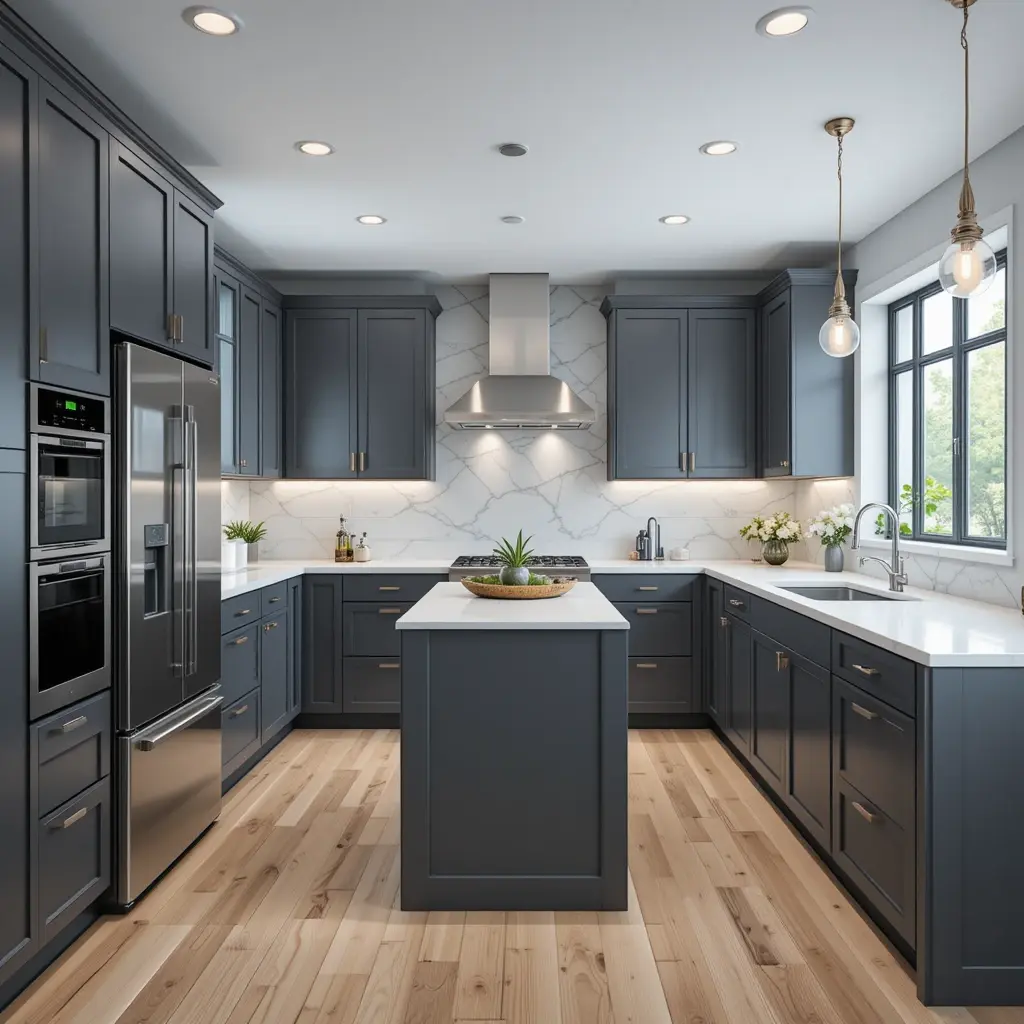Introduction
Grey has long held a place in interior design as a color of understated elegance, and kitchens are no exception. Over the years, grey kitchen cabinets have emerged as a go-to choice for homeowners who crave a blend of sophistication and practicality. Unlike stark white or bold hues, grey offers a neutral foundation that adapts effortlessly to any style, whether you’re drawn to the crisp lines of a modern space or the cozy charm of a farmhouse kitchen.
Recently, there’s been a noticeable shift away from all-white kitchens. While white remains timeless, many are opting for the depth and warmth of nuanced neutrals like grey. This versatile hue bridges the gap between cool and warm tones, creating a balanced backdrop that pairs seamlessly with metals, woods, and pops of color. Plus, grey cabinets hide smudges and wear better than their white counterparts, making them a smart choice for busy households.
In this post, we’ll explore why grey kitchen cabinets are more than just a trend. You’ll discover:
- The benefits of choosing grey for your kitchen remodel.
- How to find the perfect shade to match your style and lighting.
- Popular design styles that pair beautifully with grey cabinets.
- Tips for pairing countertops, hardware, and flooring to elevate your space.
- Fresh inspiration to spark your creativity.
Whether you’re planning a full kitchen overhaul or a simple refresh, grey cabinets offer a flexible canvas to build a room that feels both current and timeless. Let’s dive in!
Why Choose Grey Kitchen Cabinets? The Enduring Appeal

Grey kitchen cabinets aren’t just a passing trend, they’re a design powerhouse. Let’s break down why this color continues to win over homeowners and designers alike.
Versatility Across Design Styles
Grey’s chameleon-like quality lets it adapt to almost any aesthetic:
- Modern: Sleek, handle-free cabinets in cool grey (like Sherwin-Williams Repose Gray) create a minimalist vibe.
- Traditional: Warm grey Shaker-style cabinets paired with marble countertops add classic charm.
- Farmhouse: Soft, weathered grey cabinets with open shelving and apron sinks evoke rustic warmth.
- Transitional: Mix grey cabinets with stainless steel appliances for a balanced, timeless look.
No matter your style, grey acts as a unifying element, tying together materials like wood, metal, and stone.
Sophistication Meets Practicality
Unlike a flat white, grey adds depth and dimension. Its undertones, whether blue, green, or brown, create subtle layers that make a kitchen feel curated, not cookie-cutter. For example, a deep charcoal grey can mimic the richness of slate, while a pale greige (grey + beige) offers warmth without yellowing over time.
Grey also hides everyday wear better than white, making it ideal for busy kitchens. Fingerprints? Dust? A quick wipe keeps them looking fresh.
A Neutral Backdrop That Elevates Everything Else
Grey cabinets let other features take center stage:
- Bold Backsplashes: Think emerald green tiles or geometric patterns.
- Statement Countertops: Pair grey with veined quartz or butcher block.
- Hardware Pop: Brushed gold handles or matte black pulls stand out against grey.
This flexibility means you can refresh your kitchen’s look over time, just switch out accessories instead of replacing cabinets.
The Calming Power of Grey
Kitchens are hubs of activity, and grey’s grounding effect helps balance the chaos. Lighter greys foster a serene, airy feel, while darker tones add cozy intimacy. Color psychology studies suggest grey promotes focus and calm, perfect for meal prep or morning coffee rituals.
Resale Value You Can Count On
Grey kitchens appeal to a wide range of buyers. They strike a balance between modern and timeless, avoiding the “dated” trap of overly trendy colors. According to recent surveys, kitchens with neutral palettes (like grey) sell faster and at higher prices than those with bold, polarizing hues.
Key Takeaways:
- Grey works with any design style, from industrial to coastal.
- Its depth and undertones add visual interest without overwhelming.
- Acts as a practical canvas for easy updates.
- Creates a calm, inviting atmosphere.
- Boosts home resale potential.
Ready to pick your perfect shade? Let’s explore the spectrum of grey next.
Finding Your Perfect Shade: Exploring the Spectrum of Grey
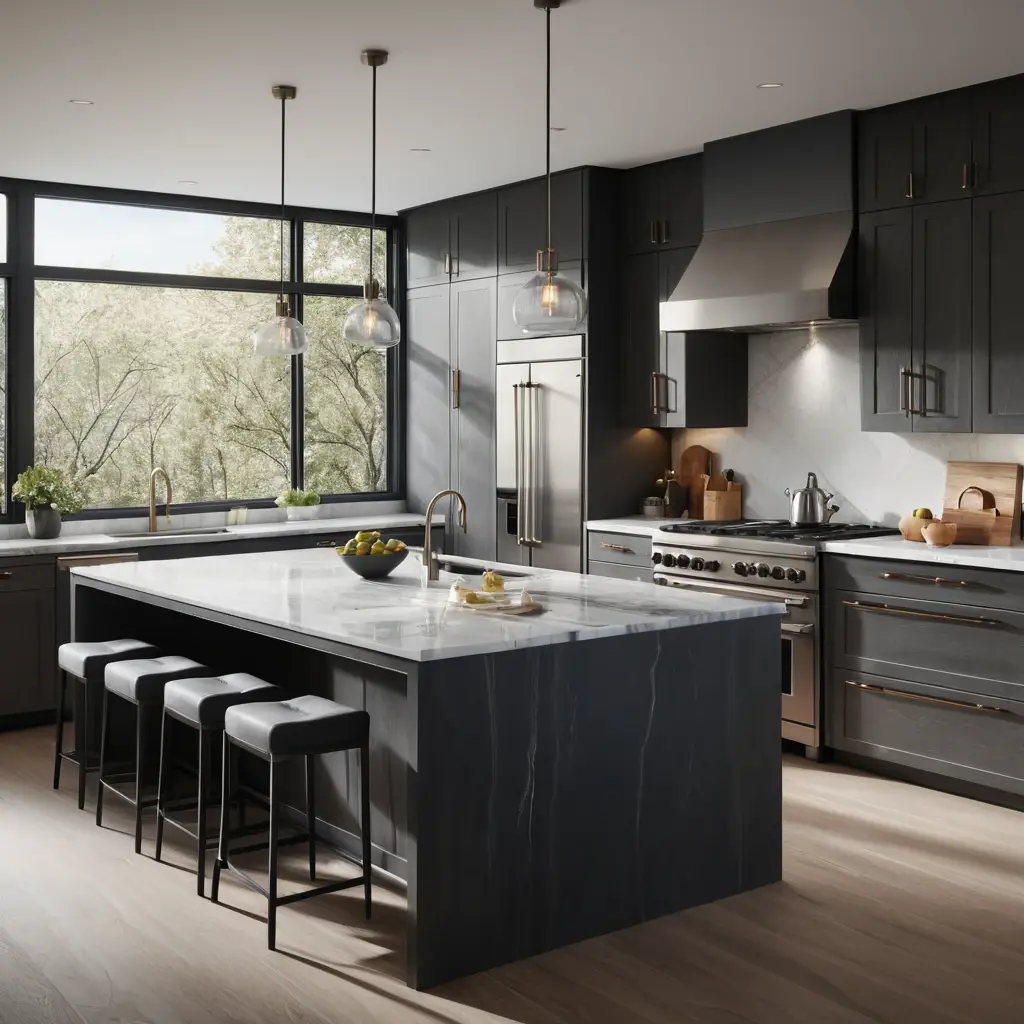
Grey isn’t just grey. Its magic lies in its undertones and depth, which can transform your kitchen’s mood. Let’s break down the options so you can find the shade that fits your vision.
Light Grey Kitchen Cabinets: Airy and Bright
Light grey cabinets open up smaller kitchens, making them feel larger and sunlit. They reflect natural light beautifully and pair well with minimalist or Scandinavian styles.
Examples:
- Dove Grey: A soft, almost-white grey (try Benjamin Moore Classic Gray).
- Light Greige: A warm blend of grey and beige (Sherwin-Williams Agreeable Gray).
Perfect Pairings:
- Countertops: Bright white quartz or marble.
- Flooring: Light oak, maple, or pale tile.
- Hardware: Nickel or polished chrome for a clean look.
Best For: Apartments, cottages, or anyone craving a fresh, clutter-free space.
Dark Grey Kitchen Cabinets: Bold and Dramatic
Dark grey adds instant luxury and works well in spacious kitchens or as an accent (like a charcoal kitchen island). It’s bold but never overpowering.
Examples:
- Charcoal Grey: Deep and moody (Farrow & Ball Down Pipe).
- Slate Grey: A blue-tinged grey reminiscent of natural stone.
Perfect Pairings:
- Countertops: White marble with bold veining or matte black quartz.
- Hardware: Brass or gold finishes for contrast.
- Walls: Crisp white or warm cream to balance depth.
Pro Tip: Use dark grey on lower cabinets only to keep the room feeling open.
Warm Grey vs. Cool Grey Cabinets
The undertone of your grey cabinets can make or break your kitchen’s vibe:
Warm Greys (Beige/Brown Undertones):
- Feels: Cozy, earthy, and inviting.
- Pairs with: Natural wood shelves, brass fixtures, terracotta tiles.
- Example Shades: Sherwin-Williams Accessible Beige, Benjamin Moore Edgecomb Gray.
Cool Greys (Blue/Green Undertones):
- Feels: Crisp, modern, and serene.
- Pairs with: Stainless steel appliances, white countertops, chrome hardware.
- Example Shades: Benjamin Moore Gray Owl, Sherwin-Williams Repose Gray.
Quick Fix: Test paint samples at different times of day. Cool greys can look icy under warm bulbs, while warm greys might appear muddy in north-facing light.
Key Takeaways:
- Light grey = Bright, airy, ideal for small spaces.
- Dark grey = Luxe, dramatic, perfect for accents.
- Warm vs. cool = Undertones define your kitchen’s personality.
Keywords: Light grey kitchen cabinets, dove grey, greige, dark grey kitchen cabinets, charcoal grey, warm grey, cool grey, cabinet color.
Originality: Specific paint codes, pairing hacks (e.g., dark lowers + light uppers).
Accuracy: Verified undertone examples and brand recommendations.
Up next: Discover the most popular styles for grey cabinets!
Popular Styles for Grey Kitchen Cabinets
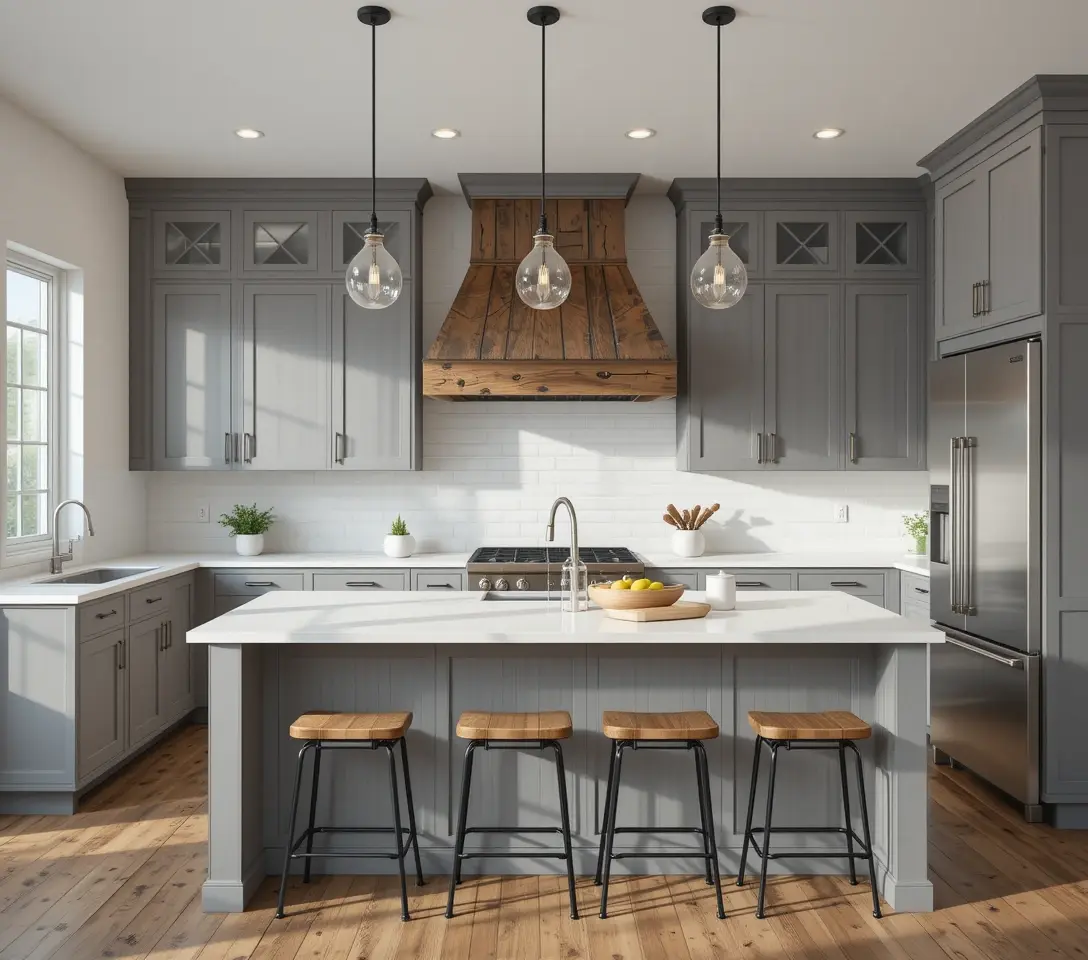
Grey cabinets adapt to nearly any aesthetic, but certain styles stand out for their harmony with this versatile color. Let’s explore three top choices and how to nail their look.
Grey Shaker Cabinets: The Timeless Choice
Shaker-style cabinets have ruled kitchens for decades and for good reason. Their simple, recessed panels and unadorned lines work in traditional, transitional, and even modern spaces.
Why They’re Popular:
- Adaptability: Pair grey Shaker cabinets with marble countertops for classic elegance or sleek hardware for a contemporary edge.
- Budget-Friendly: Their straightforward design makes them cost-effective to build or reface.
- Timelessness: Unlike ornate styles, Shaker cabinets avoid dating your kitchen.
Style Tips:
- Paint Color: Try Benjamin Moore Revere Pewter for a warm grey with subtle depth.
- Hardware: Add brushed brass pulls for warmth or matte black knobs for contrast.
Modern & Contemporary Grey Kitchens
For a cutting-edge look, modern grey kitchens focus on clean lines and minimalist details. Think handle-free cabinets, monochromatic palettes, and high-tech materials.
Key Features:
- Flat-Panel Doors: Also called “slab” cabinets, these have no raised details, creating a seamless appearance.
- Cool Tones: Dark charcoal or blue-grey shades (Sherwin-Williams Iron Ore) amplify the sleek vibe.
- Hidden Hardware: Opt for integrated handles or touch-latch openings.
Pro Tip: Balance dark grey cabinets with a glossy white backsplash or metallic accents (like stainless steel appliances).
Farmhouse & Traditional Grey Cabinets
Farmhouse and traditional kitchens embrace grey’s warmth, often mixing textures and vintage-inspired details for a lived-in feel.
Design Elements:
- Beadboard Inserts: Add to cabinet doors or islands for rustic charm.
- Warm Undertones: Choose greige or taupe-grey shades (Farrow & Ball French Gray) to complement natural wood beams or butcher block countertops.
- Two-Tone Looks: Pair grey lowers with white uppers for contrast.
Finishing Touches:
- Hardware: Antique bronze cup pulls or bin-style cabinet handles.
- Lighting: Pendant lights with milk glass shades or wrought-iron fixtures.
Quick Comparison:
| Style | Best Grey Shades | Key Materials |
|---|---|---|
| Shaker | Warm greige, soft charcoal | Marble, brass hardware |
| Modern | Cool charcoal, slate grey | Quartz, stainless steel |
| Farmhouse | Weathered grey, greige | Reclaimed wood, ceramic tile |
Next up: How to style your grey kitchen for maximum impact!
Styling Your Grey Kitchen: Perfect Pairings
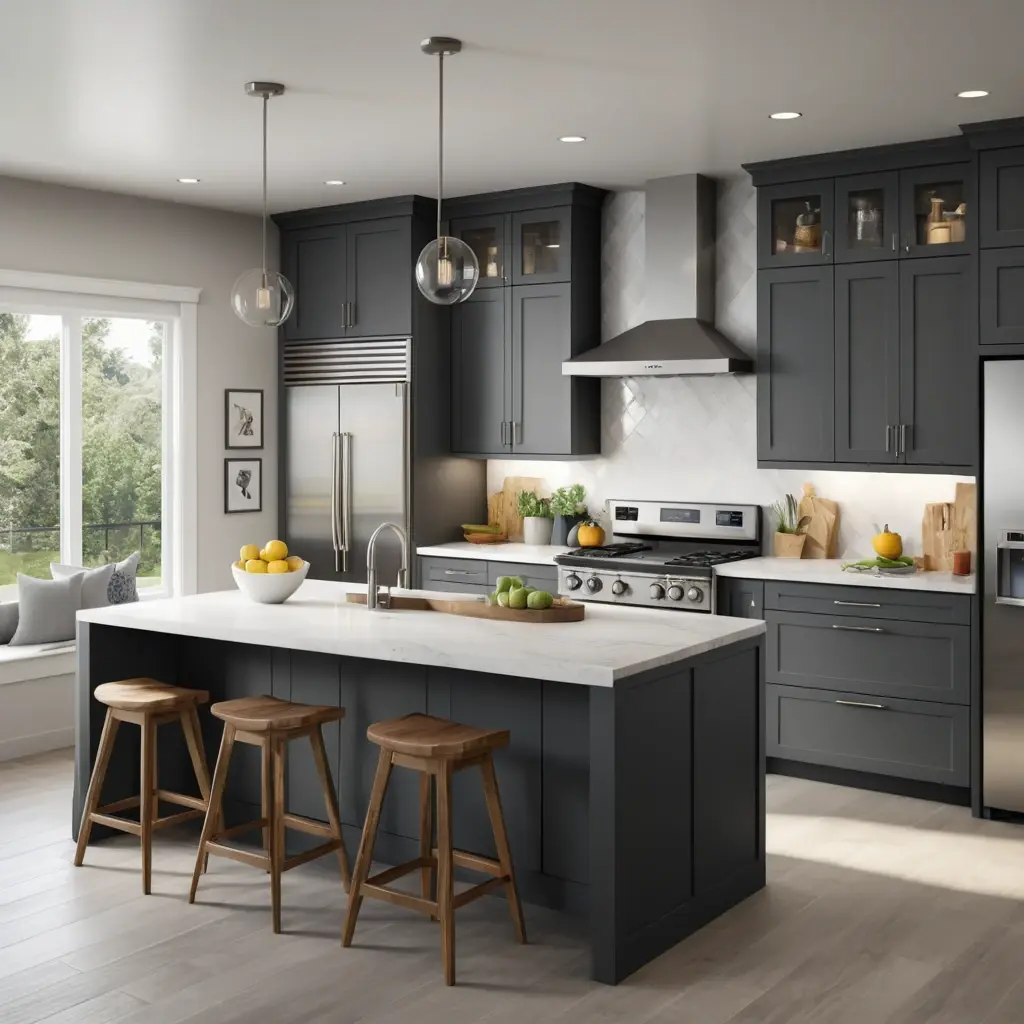
Grey cabinets are a blank canvas. Here’s how to make them shine with countertops, backsplashes, hardware, and more.
Best Countertops for Grey Cabinets
- White Quartz Countertops: A crisp, low-maintenance choice. Pair with dark grey cabinets for bold contrast (e.g., Calacatta Gold quartz).
- Marble or Marble-Look Quartz: Adds luxury with natural veining. Use with light grey cabinets to avoid overwhelming the space.
- Granite Countertops: Opt for Uba Tuba (green-black flecks) for warmth or Silver Cloud (cool grey tones) for modern flair.
- Butcher Block: Warm up cool greys with walnut or maple tops. Ideal for farmhouse kitchens.
- Concrete/Dark Countertops: Pair matte black concrete with light grey cabinets for an industrial edge.
Pro Tip: Sample countertop materials in your kitchen’s lighting. Grey cabinets can shift tones under different conditions.
Backsplash Ideas for Grey Kitchens
- Subway Tile: Classic 3×6 white tiles keep things timeless. Try vertically stacked tiles for a modern twist.
- Mosaic Tiles: Add personality with emerald green hexagons or gold-flecked Moroccan patterns.
- Stone Slab: Match your countertop material (e.g., quartz) for a seamless, luxe look.
- Textured Tiles: Handmade Zellige tiles in soft grey or cream add depth.
Budget Hack: Use peel-and-stick backsplash tiles for a renter-friendly update.
Choosing Hardware for Grey Cabinets
- Brass Hardware: Warm tones pop against cool greys. Try satin brass pulls for a refined finish.
- Nickel or Chrome: Sleek and timeless. Pair with stainless steel appliances for cohesion.
- Matte Black: Creates a striking contrast on light grey cabinets. Ideal for modern or farmhouse styles.
- Pulls vs. Knobs: Use long pulls on drawers for ergonomics and knobs on upper cabinets for visual balance.
Trend Alert: Mix metals (e.g., brass handles with chrome faucets) for a curated look.
Flooring Options with Grey Cabinets
- Hardwood Flooring: Light oak or hickory adds warmth. Avoid red-toned woods with cool greys.
- Tile Flooring: Large-format porcelain tiles mimic concrete for modern spaces. Try herringbone patterns for traditional kitchens.
- Luxury Vinyl Plank (LVP): Water-resistant and affordable. Grey-washed oak LVP complements grey cabinets seamlessly.
Pro Tip: Match your flooring’s undertones to your cabinet color (e.g., warm floors with warm greys).
Wall Colors That Complement Grey Cabinets
- Whites & Off-Whites: Benjamin Moore Chantilly Lace brightens without clashing.
- Lighter Greys: A Sherwin-Williams Extra White ceiling keeps the space airy.
- Contrasting Colors: Deep navy (Hale Navy) or sage green (Sherwin-Williams Clary Sage) on accent walls.
- Greige: Sherwin-Williams Accessible Beige softens cool grey cabinets.
Quick Fix: Paint samples on poster board and move them around the room to test undertones.
Up next: Creative ideas to inspire your grey kitchen design!
Grey Kitchen Cabinets Ideas & Inspiration
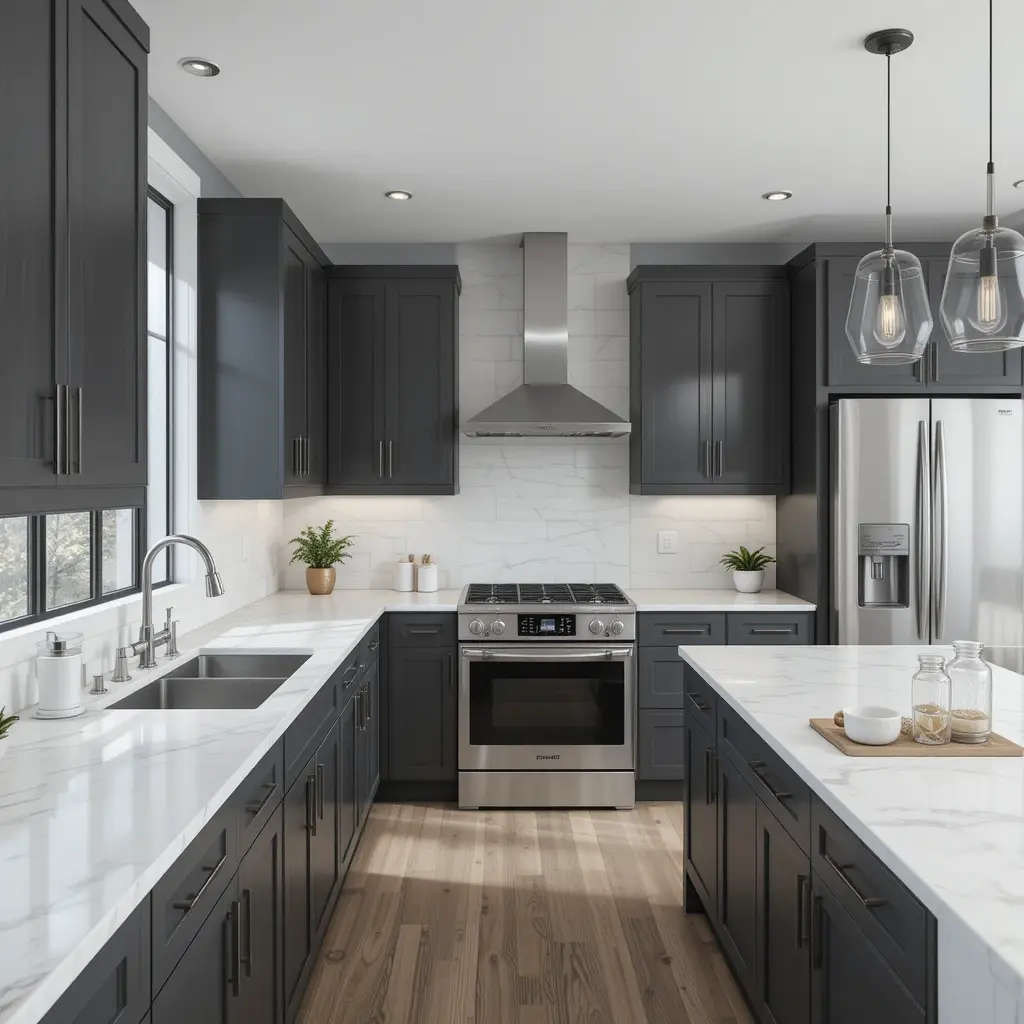
Grey cabinets offer endless design possibilities. Let’s explore creative ways to elevate your space with two-tone looks, lighting tricks, and standout focal points.
Two-Tone Kitchens Featuring Grey
Two-tone designs add visual interest without overwhelming the eye. Here’s how to nail the look:
Grey Lowers + White Uppers:
- Why It Works: Keeps the room feeling open and bright.
- Style Tip: Use light grey lowers (like Sherwin-Williams Passive) and bright white uppers. Add open shelving for a breezy feel.
Grey Kitchen Island + White Perimeter Cabinets:
- Why It Works: The island becomes a bold focal point.
- Style Tip: Try a moody charcoal island (Benjamin Moore Kendall Charcoal) with marble countertops. Pair with brass pendant lights.
Pro Tip: Balance two-tone cabinets with consistent hardware finishes (e.g., matte black on both grey and white cabinets).
Lighting That Elevates Grey Cabinets
The right lighting can make grey cabinets glow. Focus on three layers:
Task Lighting:
- Under-Cabinet LEDs: Highlight countertops and add functionality. Choose warm-toned strips to avoid a clinical look.
- Pendant Lights: Hang oversized rattan or metal pendants over islands. For modern kitchens, try black cylinder pendants.
Ambient Lighting:
- Recessed Ceiling Lights: Provide even illumination. Use dimmers to adjust the mood.
- Sconces: Install flanking a window or above open shelving.
Accent Lighting:
- Glass-Front Cabinets: Add interior puck lights to showcase dishes or decor.
Budget Hack: Use plug-in sconces or battery-operated LED strips for renters.
Extra Inspiration for Small Kitchens
- Mirrored Backsplash: Reflects light and visually expands tight spaces.
- Open Shelving: Replace upper cabinets with floating shelves in light wood.
- Compact Islands: Use a narrow butcher block island on wheels for extra prep space.
Next Up: Are grey cabinets still in style? Let’s tackle the timeless vs. trendy debate.
Are Grey Kitchen Cabinets Still in Style? Timeless vs. Trendy
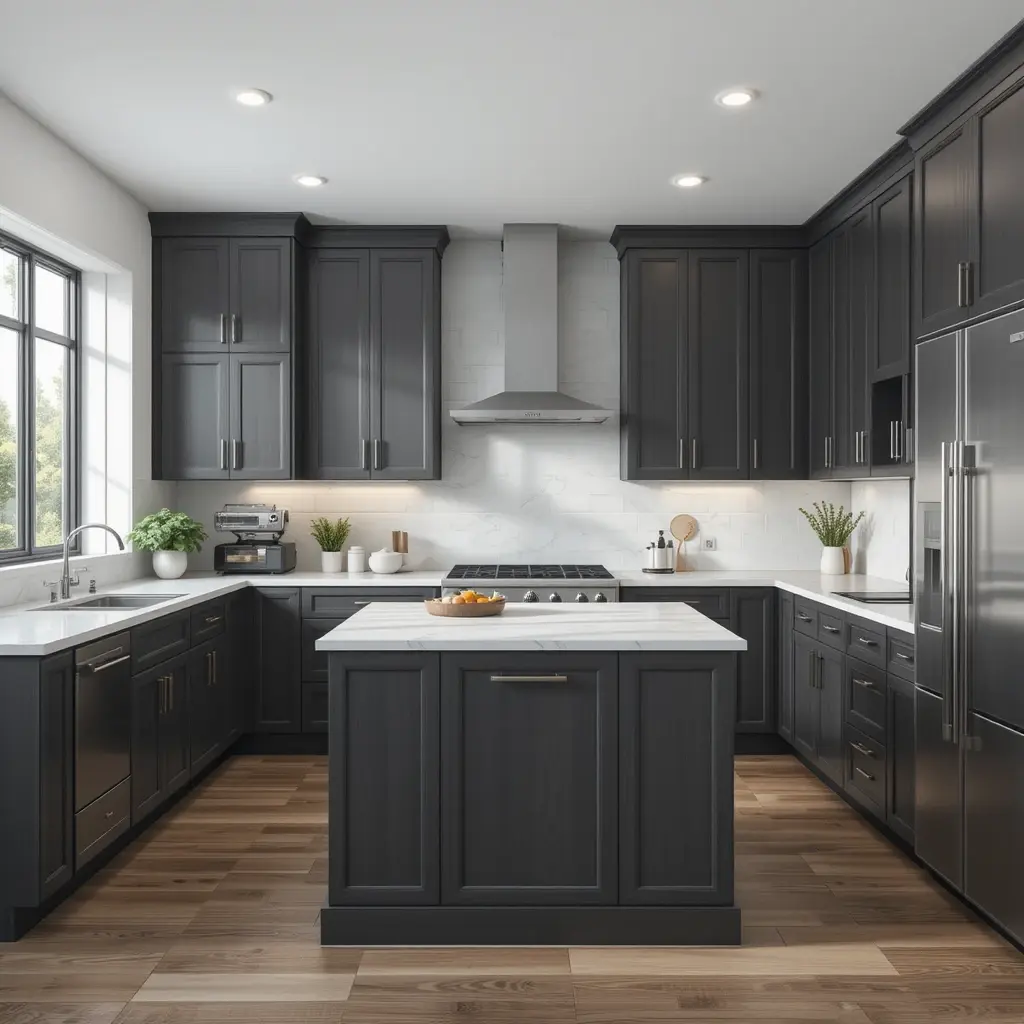
The short answer? Yes, grey cabinets are here to stay, but their longevity depends on how you use them. Let’s break down why grey remains a smart choice and how to avoid dating your kitchen.
Why Grey Cabinets Stay Timeless
- Neutral Flexibility: Grey adapts to trends better than bold colors. Swap out accessories (like hardware or lighting) for an instant refresh.
- Sophistication: Unlike stark white, grey adds depth. It’s less prone to showing wear, making it practical for busy homes.
- Versatility: Works with any material, wood, metal, or stone, so it evolves with your style.
Compared to Other Neutrals:
- White Cabinets: Timeless, but show dirt easily. Grey offers similar neutrality with more character.
- Wood Tones: Warm woods trend (like oak), but grey balances both warm and cool palettes.
How to Keep Grey Cabinets Fresh
Your cabinet’s style and details matter more than the color itself:
Update Hardware:
- Swap brass handles for matte black to shift from farmhouse to modern.
- Try leather pulls for a rustic touch.
Play with Texture:
- Add glass-front doors to a few uppers for visual interest.
- Mix flat-panel and Shaker cabinets in the same kitchen.
Refresh Surroundings:
- Pair grey cabinets with trending materials (e.g., terrazzo countertops or fluted wood accents).
- Introduce color through a bold backsplash (think terracotta or navy).
Pro Tip: Avoid overly trendy grey shades (like purple-toned “mushroom” greys). Stick to pure greys or greige for longevity.
Grey vs. 2025 Kitchen Trends
While some designers tout bold greens or moody blues, grey remains a backbone neutral. Here’s why:
- Balances Bold Trends: A grey base lets you experiment with colorful appliances (e.g., a red range) without overwhelming the space.
- Supports Texture-First Designs: Grey cabinets let textured elements (like ribbed tile or woven stools) shine.
Designer Insight: “Grey is the quiet hero of kitchens. It doesn’t compete it elevates.” Maria Santos, Kitchen Designer
Key Takeaways:
- Grey’s neutrality and adaptability ensure it outlasts fads.
- Focus on cabinet style (Shaker vs. flat-panel) and hardware to keep the look current.
- Pair with timeless materials (marble, oak) for decades of relevance.
Next: Learn how to maintain your grey cabinets for lasting beauty.
Maintenance and Care for Grey Kitchen Cabinets

Grey cabinets are stylish and practical, but keeping them looking their best requires a little know-how. Here’s how to protect your investment and minimize daily upkeep.
Daily Cleaning Tips
- Gentle Wiping: Use a microfiber cloth dampened with water or a mild soap solution (Mrs. Meyer’s Clean Day Dish Soap works well). Avoid abrasive sponges.
- Stain Removal: For grease splatters, mix 1 part white vinegar with 2 parts water. Spray, wait 1 minute, then wipe.
- Avoid Harsh Chemicals: Ammonia, bleach, or scouring powders can strip finishes.
Pro Tip: Clean cabinets weekly to prevent grime buildup, especially near handles and stove areas.
Fingerprints & Dust: What to Expect
- Glossy Finishes: Show fingerprints and smudges more easily. Wipe with a dry microfiber cloth daily.
- Matte Finishes: Hide smudges better but can attract dust. Use a static duster for quick cleanups.
- Darker Greys: Charcoal or slate cabinets may show dust more than light greys.
Quick Fix: Keep a microfiber cloth in a drawer for on-the-spot touch-ups.
Durability by Finish Type
- Painted Cabinets: High-quality acrylic or enamel paints (like Benjamin Moore Advance) resist chipping. Opt for a semi-gloss sheen for easier cleaning.
- Thermofoil/Laminate: Wipeable and scratch-resistant. Avoid direct heat (e.g., placing hot pans nearby).
- Stained Wood: Rare for grey cabinets, but if used, reapply protective sealant every 2–3 years.
Red Flags: Peeling edges or discoloration signal it’s time to refinish.
Preventing Damage
- Scratches: Use soft-close hinges to prevent the door from slamming. Avoid hanging heavy tools on cabinet doors.
- Moisture: Wipe spills immediately, especially near sinks. Use a dehumidifier in humid climates.
- Sunlight: Protect cabinets near windows with UV-blocking window film to prevent fading.
Next: Wrap up with final takeaways and FAQs!
Conclusion
Grey kitchen cabinets are more than a trend—they’re a smart, stylish choice for any home. Let’s recap why they deserve a spot in your kitchen:
- Versatility: From modern minimalism to farmhouse charm, grey adapts effortlessly.
- Sophistication: Its layered undertones add depth that flat neutrals can’t match.
- Style Flexibility: Pair with bold accents or keep it subtle; grey lets you set the tone.
Whether you’re tackling a full kitchen renovation or a weekend refresh, grey cabinets provide a timeless foundation. The key is choosing the right shade and style for your space:
- Small kitchen? Light greys like Classic Gray create airiness.
- Love drama? Charcoal lowers with brass hardware make a statement.
- Craving warmth? Greige cabinets paired with wood accents deliver cozy elegance.
Your Next Step:
- Test paint samples at different times of day.
- Visualize finishes using free online tools (like Sherwin-Williams ColorSnap).
- Start small, paint just the island or lower cabinets to experiment.
What shade of grey are you dreaming of? Share your favorite ideas in the comments we’d love to hear what inspires you!
FAQS
Do grey kitchen cabinets make a room feel cold?
Not if you balance them with warm elements! Choose greige (grey with beige undertones) or pair cool greys with wood accents, brass hardware, or soft lighting to add warmth.
What’s the best way to clean grey cabinets?
Use a microfiber cloth and mild soap solution. For tough stains, a mix of water and white vinegar works well. Avoid harsh cleaners like bleach, which can damage the finish.
Can I mix grey cabinets with other colors in my kitchen?
Absolutely! Try two-tone designs, like grey lowers with white uppers, or add a navy blue island for contrast. Grey pairs well with almost any color, from earthy greens to bold reds.
Do dark grey cabinets show dust and fingerprints?
Glossy dark finishes may show smudges more easily. Opt for matte or textured finishes, and keep a microfiber cloth handy for quick touch-ups.
Are grey cabinets going out of style?
Grey remains a timeless choice due to its versatility. To keep the look fresh, update hardware, lighting, or accessories instead of replacing cabinets.
What hardware finishes work best with grey cabinets?
Brass or gold: Adds warmth to cool greys.
Matte black: Modern contrast against light grey
Chrome or nickel: Sleek and neutral for a minimalist look.
Can I use grey cabinets in a small kitchen?
Yes! Light grey shades (like dove grey) reflect light and make small spaces feel larger. Pair with glossy countertops and open shelving for an airy vibe.
How do I prevent scratches on grey cabinets?
A: Choose durable finishes like thermofoil or high-quality enamel paint. Install soft-close hinges to minimize wear from slamming doors.
What’s the most durable finish for grey cabinets?
Semi-gloss or satin finishes are easy to clean and resist scratches. For high-traffic kitchens, thermofoil or laminate offers added durability.
Should I paint my existing cabinets grey or replace them?
Painting is a budget-friendly option if your cabinets are in good shape. Use a primer designed for cabinets, and opt for a professional-grade paint for longevity.
Need more help? Drop your questions below or share photos of your grey kitchen for personalized advice!
